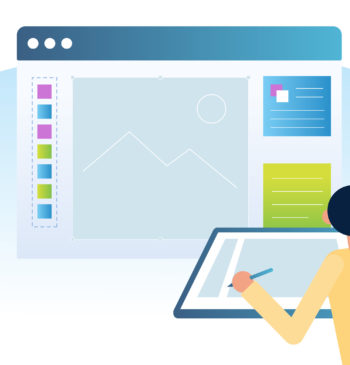
Are you an in-house graphic designer tired of working on a single brand day-in and day-out? Or maybe you work for an agency but are tired of answering to creative directors? There are myriad reasons to think about starting a graphic design business—whatever your reason, there’s no better time than now to start your journey to agency ownership. Read on for the essential tools and guidance needed to start a design business from scratch.
Business Plan
You likely already have a vision for the type of work you want to do, and might even already have a client or two ready to take the plunge with you. But before you take the leap to starting your own design agency, it’s critical to develop a business plan for your agency.
More than simply outlining your target customers, market opportunity, and financial objectives, a business plan also serves as a guidepost as you grow your agency, ensuring every decision you make along your journey stays true to the vision you are developing right now. This isn’t to say your path won’t take unexpected twists and turns (quite the contrary)—but your business plan will help you determine which opportunities to say “yes” to, and which to decline, protecting your design business from going down too many rabbit holes and diluting your agency positioning.
Your business plan will also help you as you consider more tactical decisions when starting a graphics design business. For example, the project management tools you invest in will largely depend on the types of clients you intend to serve. Different clients and different types of work require different tools to guide your work through your creative process. As you evaluate all the design, project management, and communication tools available to you, keep referring to your business plan to ensure you make decisions that align with the type of clients you want to work with and the type of services you intend to provide to them.
Read our article on graphic design business plans for a deeper exploration of these must-haves for anyone starting a graphic design business.
Tools of the Trade
Design Tools
If you’re actively learning about starting a graphic design business you’ve probably got a strong grasp on the tools needed to produce your work. The Adobe Creative Cloud is the de facto standard when it comes to professional design tools, so you likely already have proficiency with a number of Adobe apps. If for whatever you don’t have experience with Adobe apps (for example, if you learned design with free or open source tools) you’ll need to learn the Adobe ecosystem as soon as possible. The vast majority of clients will expect you to be familiar with the tools they use, and will likely deliver any working files you may need in Photoshop, Illustrator, InDesign, or other formats. A proficiency in these apps is critical—plus, a subscription to Adobe Creative Cloud grants you access to their full breadth of apps, offering you the opportunity to expand your skill set into other areas such as video editing, motion graphics, sound design, and more. After all, part of starting a graphic design business is figuring out how you can deliver even more value to your clients.
Beyond Adobe’s offering, there are numerous digital tools to help support you on the path to starting a design business:
- Webflow lets you create beautiful, responsive websites and pages without requiring any knowledge of code. You can import .svg assets from your design mockups and easily build and deploy sites in the Webflow ecosystem, or you have the option to export all the packaged code and source files for deployment on a client’s server or elsewhere.
- Figma is like Google Docs, but for design. This collaborative prototyping tool is great for prototyping work and user experience design. Your clients will love the ability to jump right in and make edits to copy, and you’ll love how easy it is to move from wireframe to fully-designed prototype within a single environment.
- For more robust prototyping needs, ProtoPie is a must-have. ProtoPie enables incredibly high-fidelity prototyping in a highly-collaborative environment. Your clients will hardly see the difference between a ProtoPie prototype and their final app.
- Removebg is a new photo editing tool that automatically removes the background from any photo you upload. This is a must-have for any photo-heavy design work, saving you hours of tedious production work.
Project Management Tools
When it comes to project management tools, it’s easy to go down a rabbit hole exploring the dozens of options out there. Check out this article for an overview of 40 project management tools. When reviewing options, it’s important to consider the type of work you are doing for your clients and the process structure through which your work moves. For example, are you typically working on a single large deliverable for your client that moves through a very clear set of milestones? Or are you working on a large volume of smaller deliverables that don’t always move through clear milestones? Different tools cater to different cadences of work.
All that said, you’ll be expected to have some familiarity with the heavy hitters out there (such as Basecamp, Asana, Trello, and others), as often your clients will invite you as a guest account in their project management workstreams. Once you understand the basics of any project management tool, it’s really just a matter of understanding how each platform looks at milestones and tasks.
Communication Tools
As you are just starting a graphics design business, when it comes to communicating with your clients (or within your own growing design agency), simpler is often better. Think about your and your clients’ communication preferences, and build a tool set around those. For example, do you typically communicate on email with your clients? Or are you more likely to pick up the phone and give them a call? Are video calls your preferred method of communication? Or would you rather send casual chat messages to your clients?
There’s no getting around email as a core component of your communication plan. There isn’t a lot to say here, as we’ve all been using email for years. Save yourself some headache and go with a paid Gmail account.
For more casual asynchronous communications, Slack and Microsoft Teams are the most popular options. You can build channels around specific projects, campaigns, or accounts, and can even invite your clients as guest users in these channels. This is a great area to quickly send one-off questions to your clients without the formality of an email or meeting.
There has been an explosion in options for video calls and screen share presentations. If you and your clients both use Slack or Teams, you can conduct video calls directly through these apps. Gmail also provides video conferencing and screen sharing capabilities. When it comes to dedicated video conference solutions, here are the key players:
Which option you go with largely depends on personal preference, but it’s important to consider all potential conferencing needs you may have in the future. For example, will you be hosting webinars as part of your thought leadership efforts? As you consider starting a design business, research each tool to see which best fits all possible use cases you may have.
Final Thoughts
It bears repeating that your business plan is the best guide available to you as you consider all these options for design and project management tools. Starting a graphic design business can feel overwhelming as you get into the weeds of selecting the core pieces of your production process. A clear vision for your agency’s future will ensure you make the right choices from day one.




